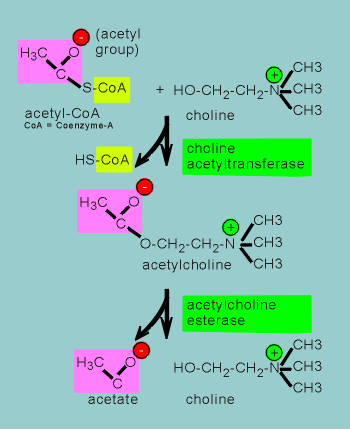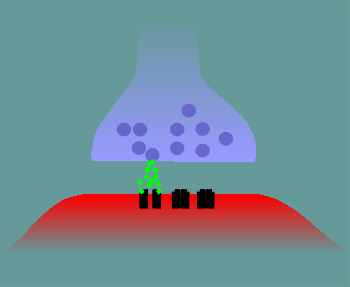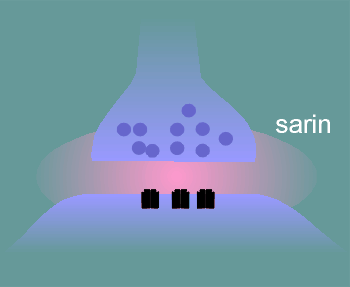 The endogenous ligand for the nicotinic receptor, acetylcholine, is
synthesized in nerve terminals by the enzymatic transfer of an acetyl group to choline.
The endogenous ligand for the nicotinic receptor, acetylcholine, is
synthesized in nerve terminals by the enzymatic transfer of an acetyl group to choline. The endogenous ligand for the nicotinic receptor, acetylcholine, is
synthesized in nerve terminals by the enzymatic transfer of an acetyl group to choline.
The endogenous ligand for the nicotinic receptor, acetylcholine, is
synthesized in nerve terminals by the enzymatic transfer of an acetyl group to choline.
Acetyl-coenzyme-A is the acetate doner and the enzyme responsible for the transfer is choline acetyltransferase.
Once released from the nerve terminal acetylcholine is rapidly broken down to acetate and choline.
The enzyme responsible for this inactivation of acetylcholine is acetylcholine esterase.
The purpose of this rapid inactivation is to limit the time that acetylcholine is in the synapse to activate post-synaptic nicotinic receptors.
The enzymatic inactivation of acetylcholine has been used for the development of a number of phamacological agents.
Anticholinesterases such as sarin are potent neurotoxins and have been used as nerve gases since World War II. (The name comes from the first manufactures of the gas, Schrader, Ambrose, Rudiger and van der Linde).
Other anticholinesterases include organophosphates (such as parathion) which are widely used as insecticides.
Anticholinesterases, whether targeted to the neuromuscular junction in a human or a worm, function the same way...instead of the released ACh being rapidly broken down in the synaptic cleft, it rapidly accumulates.

 Shown here is the normal neuromuscular junction (left) and one poisoned by
sarin (right).
Shown here is the normal neuromuscular junction (left) and one poisoned by
sarin (right).
In the normal junction ACh (green circles) rapidly disappears following its release.
This dissapearance comes about through the action of acetylcholine esterase.
Consequently the ACh released, working through nicotinic receptors, leads to discrete single depolarizations of muscle fibers (depolarizations indicated in red).
In the sarin poisoned junction, the acetylcholine esterase is inhibited and consequently ACh accumulates in the synapse.
This leads to muscle fibrillation and ultimately depolarization-induced inactivation of the muscle.
This action of sarin nicely demonstrates that it is important that signaling molecules, such as neurotransmitters, have short half-lives.
With a long half-life, control in the system is lost.